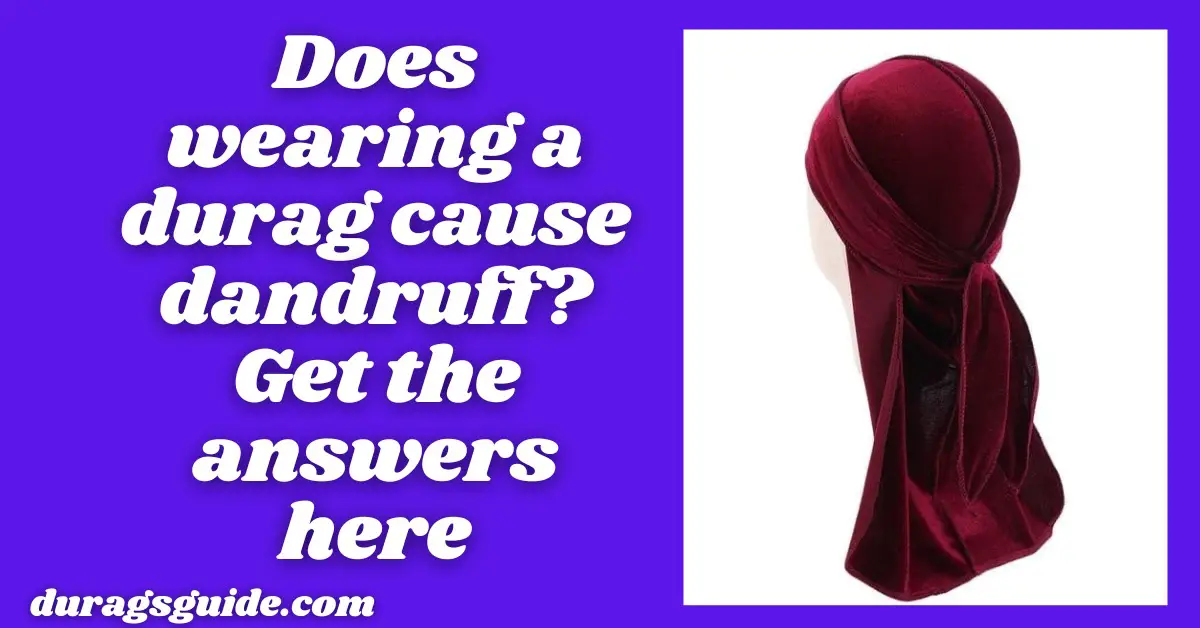Introduction
Dandruff is a common scalp issue that many individuals face, but could wearing a durag be contributing to the problem? In this article, we delve into the relationship between durag usage and dandruff, exploring question about Does Wearing a Durag Cause Dandruff? Get the Answers Here in an easy way. Let’s uncover the truth behind this intriguing topic and discover practical tips for maintaining a healthy scalp while rocking your favorite durag styles.
Understanding Dandruff: Causes and Symptoms
Dandruff is a common scalp condition characterized by flaking of the skin on the scalp, often accompanied by itching. While the exact cause of dandruff is not fully understood, several factors are believed to contribute to its development. One major factor is the overgrowth of a yeast-like fungus called Malassezia, which is naturally present on the scalp. When this fungus grows excessively, it can lead to irritation and increased shedding of skin cells, resulting in dandruff.
Other potential causes of dandruff include dry skin, seborrheic dermatitis (a more severe form of dandruff), sensitivity to hair care products, and certain medical conditions such as psoriasis or eczema. Additionally, factors like stress, hormonal changes, and poor diet may also play a role in the development of dandruff.
Symptoms of dandruff typically include white or yellowish flakes of skin on the scalp, itching, and scalp irritation. These symptoms may vary in severity and can be persistent or intermittent.
Understanding the underlying causes and symptoms of dandruff is essential for effectively managing and preventing this common scalp condition. By addressing the root causes and adopting appropriate scalp care practices, individuals can minimize dandruff flare-ups and maintain a healthy scalp environment.
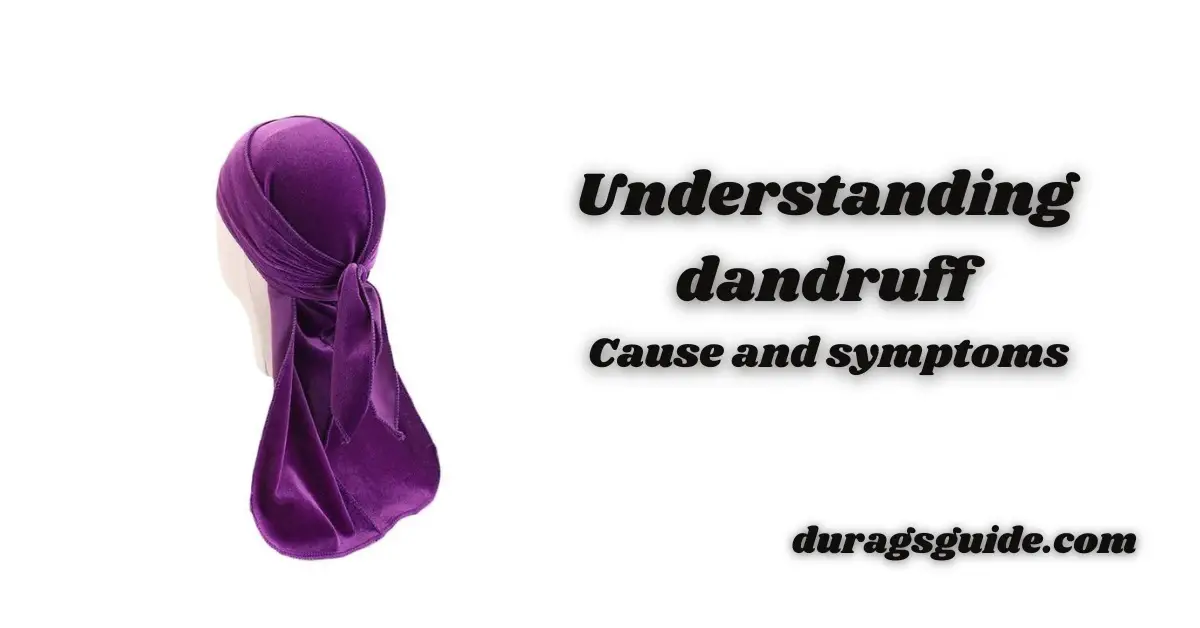
The Relationship Between Durag Use and Dandruff
While dandruff can be caused by various factors, including genetics, hormonal changes, and certain medical conditions, the role of durag use in its development is often debated. Some individuals believe that wearing a durag can contribute to dandruff due to factors such as increased scalp moisture, friction from the fabric, or inadequate scalp ventilation.
However, the relationship between durag use and dandruff is not straightforward and may vary depending on several factors, including the type of durag worn, how it is worn, and individual scalp characteristics.
For example, durags made from materials that retain moisture, such as cotton, may create a humid environment on the scalp, potentially exacerbating dandruff in individuals prone to fungal overgrowth. Similarly, tying the durag too tightly or wearing it for extended periods without allowing the scalp to breathe can lead to friction and irritation, which may contribute to dandruff.
On the other hand, durags made from breathable and moisture-wicking materials like silk or satin may help maintain scalp health by reducing moisture buildup and friction. Additionally, proper durag hygiene practices, such as regular washing and ensuring a proper fit, can minimize the risk of dandruff associated with durag use.
Overall, while wearing a durag may have the potential to influence scalp health, its impact on dandruff is likely to vary among individuals. Understanding how different factors, including durag material, fit, and hygiene practices, interact with individual scalp characteristics can help individuals make informed choices to mitigate the risk of dandruff while wearing a durag.
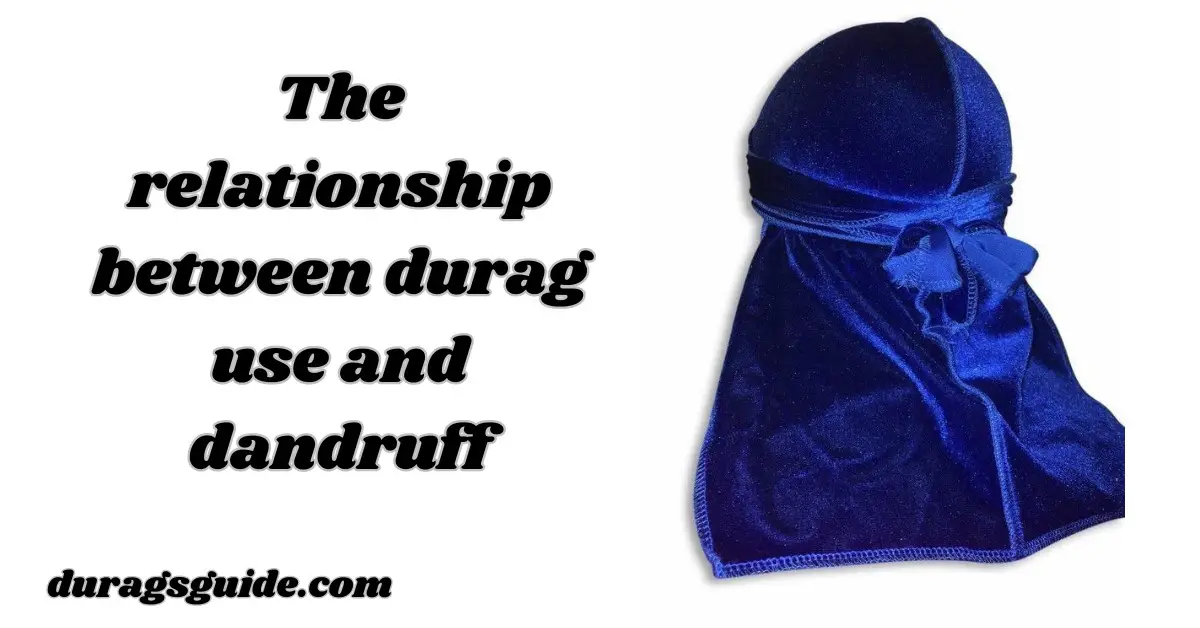
Factors Contributing to Dandruff While Wearing Durags
Several factors related to durag use can potentially contribute to the development or exacerbation of dandruff. Understanding these factors is crucial for individuals looking to minimize dandruff while wearing durags:
- Material Composition: The material composition of the durag can significantly impact scalp health. Durags made from non-breathable materials like cotton may trap moisture and heat, creating an environment conducive to fungal growth and dandruff. Conversely, durags made from breathable materials like silk or satin allow for better airflow and moisture regulation, reducing the risk of dandruff.
- Tightness of Fit: Tying the durag too tightly can restrict blood flow to the scalp and cause increased friction, leading to irritation and dandruff. It’s essential to ensure a snug but not overly tight fit to minimize pressure on the scalp and promote proper circulation.
- Duration of Wear: Prolonged wearing of durags without allowing the scalp to breathe can contribute to dandruff. It’s advisable to give your scalp regular breaks from wearing durags, especially overnight, to prevent moisture buildup and irritation.
- Hygiene Practices: Poor durag hygiene, such as infrequent washing or reusing dirty durags, can lead to the accumulation of sweat, oil, and dead skin cells on the scalp, fostering conditions for dandruff. Regularly washing durags with mild detergent and ensuring they are thoroughly dried before reuse can help maintain scalp hygiene and reduce dandruff risk.
- Individual Scalp Sensitivity: Some individuals may have scalp conditions or sensitivities that make them more prone to dandruff when wearing durags. Factors such as sebum production, skin pH levels, and underlying skin conditions like seborrheic dermatitis can influence dandruff susceptibility.
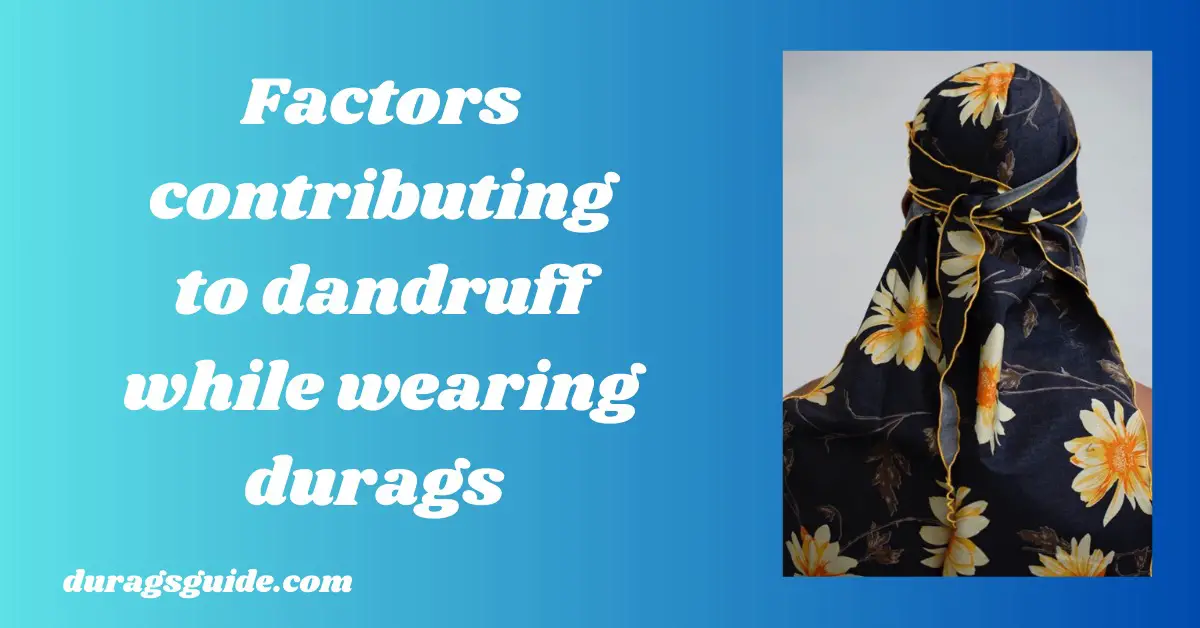
Tips for Preventing Dandruff While Wearing Durags
Preventing dandruff while wearing durags involves implementing effective scalp care practices and making informed choices regarding durag material, fit, and hygiene. Here are some tips to help minimize the risk of dandruff:
- Choose Breathable Materials: Opt for durags made from breathable materials like silk or satin, which allow for better airflow and moisture regulation compared to non-breathable fabrics like cotton. This can help prevent moisture buildup on the scalp, reducing the risk of dandruff.
- Ensure Proper Fit: Avoid tying the durag too tightly, as this can restrict blood flow to the scalp and lead to irritation and dandruff. Aim for a snug but comfortable fit that allows for free movement and proper circulation.
- Take Regular Breaks: Give your scalp regular breaks from wearing durags, especially overnight. Allowing your scalp to breathe and air out can help prevent moisture buildup and irritation, reducing the risk of dandruff.
- Practice Good Hygiene: Maintain proper durag hygiene by washing it regularly with mild detergent and lukewarm water. Avoid using harsh chemicals or abrasive scrubbing, as this can irritate the scalp and exacerbate dandruff. Ensure the durag is thoroughly dried before reuse to prevent moisture-related scalp issues.
- Use Scalp-friendly Products: Choose hair care products that are gentle on the scalp and free from harsh chemicals or irritants. Look for shampoos and conditioners specifically formulated for sensitive scalps or dandruff-prone hair to help maintain scalp health while wearing durags.
- Monitor Scalp Health: Pay attention to any signs of scalp irritation or dandruff while wearing durags. If you notice increased flaking, itching, or redness, consider adjusting your durag-wearing habits or consulting a dermatologist for further evaluation and advice.
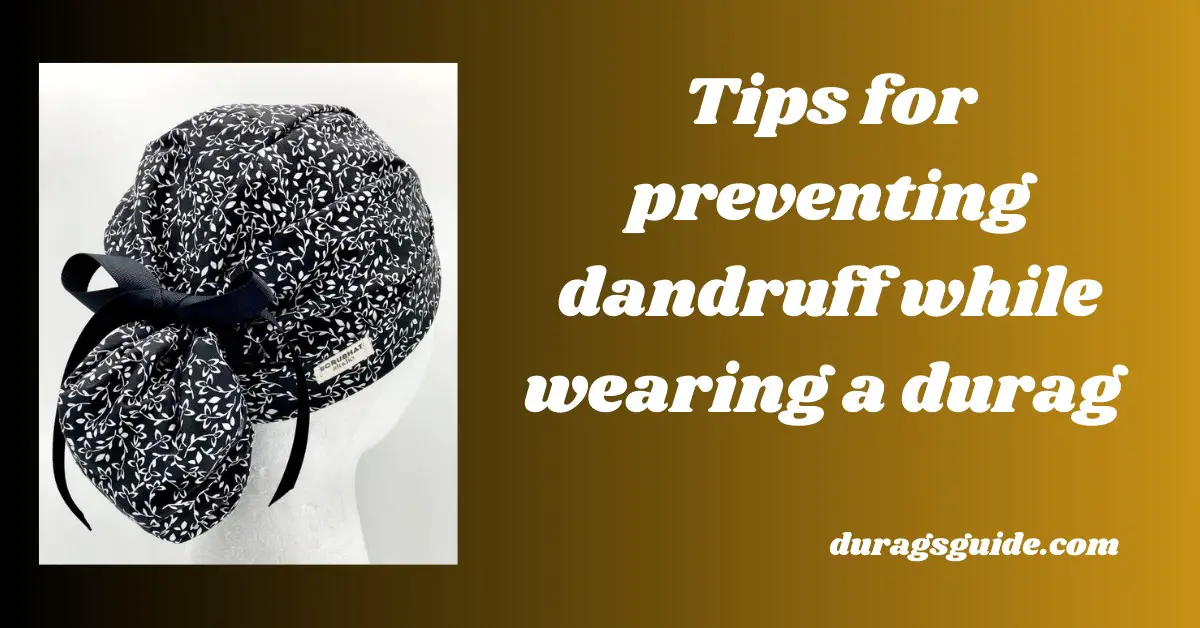
Effective Dandruff Management Strategies
If you experience dandruff while wearing a durag, it’s essential to address the issue promptly to prevent discomfort and maintain scalp health. Here are some effective strategies for managing dandruff:
- Use Anti-Dandruff Shampoos: Incorporate anti-dandruff shampoos into your hair care routine to help control flaking and itching. Look for shampoos containing active ingredients like zinc pyrithione, selenium sulfide, ketoconazole, or coal tar, which target the underlying causes of dandruff and help reduce its severity.
- Massage Scalp Regularly: Gently massaging your scalp while shampooing can help loosen and remove dead skin cells, reducing the buildup of dandruff flakes. Use your fingertips to massage the scalp in circular motions, focusing on areas prone to dandruff, such as the hairline and crown.
- Incorporate Scalp Treatments: Consider incorporating scalp treatments or masks into your hair care routine to nourish and soothe the scalp while addressing dandruff. Ingredients like tea tree oil, aloe vera, and salicylic acid have anti-inflammatory and antimicrobial properties that can help reduce dandruff and promote scalp health.
- Avoid Scratching: While it may be tempting to scratch at dandruff flakes, doing so can exacerbate irritation and inflammation, leading to further flaking. Instead of scratching, use a gentle touch and avoid overly vigorous scrubbing when shampooing or massaging the scalp.
- Maintain Moisture Balance: Strike a balance between maintaining scalp moisture and preventing excess oil buildup, as both dryness and excessive oiliness can contribute to dandruff. Use a lightweight conditioner to hydrate the hair and scalp without weighing it down, and avoid overwashing, which can strip the scalp of its natural oils and exacerbate dandruff.
- Manage Stress: Stress can exacerbate dandruff by triggering hormonal changes and weakening the immune system. Practice stress-management techniques such as deep breathing, meditation, or yoga to help reduce stress levels and promote overall scalp health.
- Consult a Dermatologist: If dandruff persists despite home remedies and over-the-counter treatments, consider consulting a dermatologist for further evaluation and personalized treatment recommendations. A dermatologist can help identify underlying causes of dandruff and prescribe targeted therapies to address them effectively.
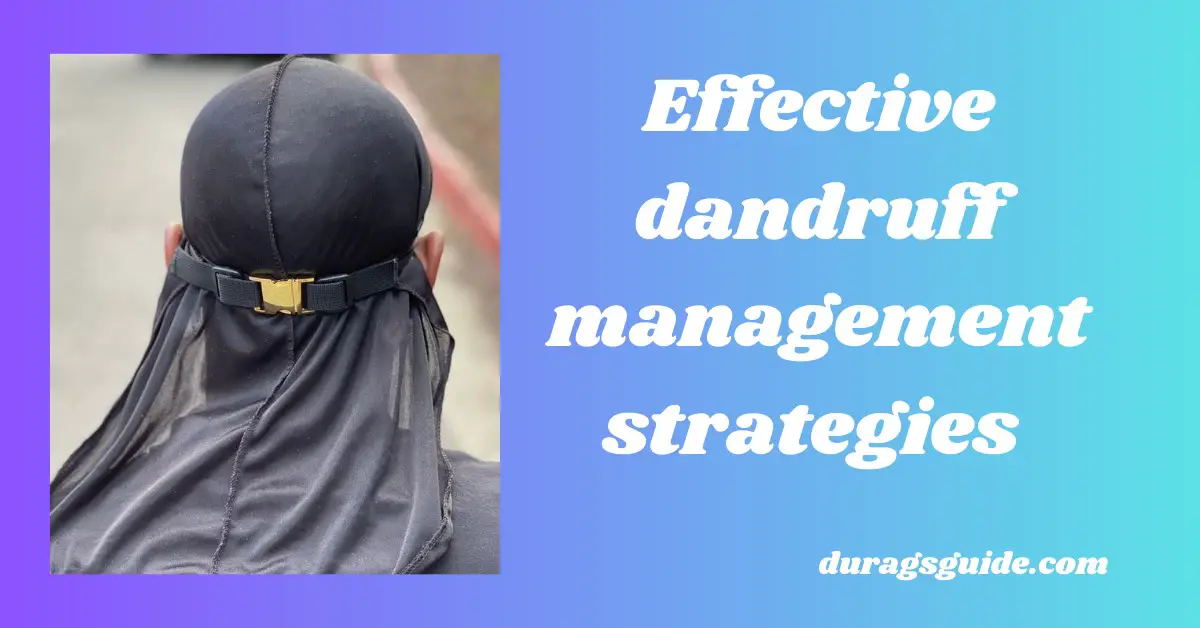
Common Misconceptions About Durags and Dandruff
Despite their widespread use, durags and dandruff are often surrounded by misconceptions. Addressing these misconceptions can help individuals make informed decisions about durag use and dandruff management. Here are some common myths debunked:
- Durags Cause Dandruff: One prevalent myth is that wearing durags directly causes dandruff. In reality, dandruff is primarily caused by factors such as dry scalp, oily skin, fungal infections, or sensitivity to hair care products. While wearing a durag may exacerbate existing dandruff by trapping moisture and heat, it is not the sole cause.
- Only People with Textured Hair Get Dandruff: Another misconception is that only individuals with textured or tightly coiled hair are prone to dandruff. Dandruff can affect people of all hair types, including straight, wavy, or curly hair. Factors such as scalp health, hygiene practices, and environmental conditions play a more significant role in dandruff development than hair texture alone.
- Durags Trap Moisture and Cause Dandruff: While it’s true that durags can trap moisture and heat against the scalp, leading to potential scalp issues, including dandruff, this is not always the case. Proper durag hygiene and wearing practices can minimize moisture buildup and reduce the risk of dandruff. Choosing breathable durag materials and allowing the scalp to air out regularly can help prevent moisture-related scalp issues.
- Dandruff is Contagious: Contrary to popular belief, dandruff is not contagious. It is a common scalp condition caused by various factors, as mentioned earlier. While certain scalp conditions may be contagious, such as fungal infections like ringworm, dandruff itself is not.
- Scratching Removes Dandruff: Some people believe that scratching the scalp vigorously can help remove dandruff flakes. However, excessive scratching can irritate the scalp further, leading to inflammation and potentially worsening dandruff. Gentle scalp massage and proper cleansing are more effective ways to manage dandruff without causing further irritation.
- Dandruff is Always Caused by Poor Hygiene: While poor hygiene can contribute to dandruff, it is not the sole cause. Other factors, such as seborrheic dermatitis, eczema, psoriasis, hormonal imbalances, or underlying health conditions, can also trigger dandruff. Maintaining good scalp hygiene is essential, but it may not always prevent dandruff in individuals predisposed to the condition.
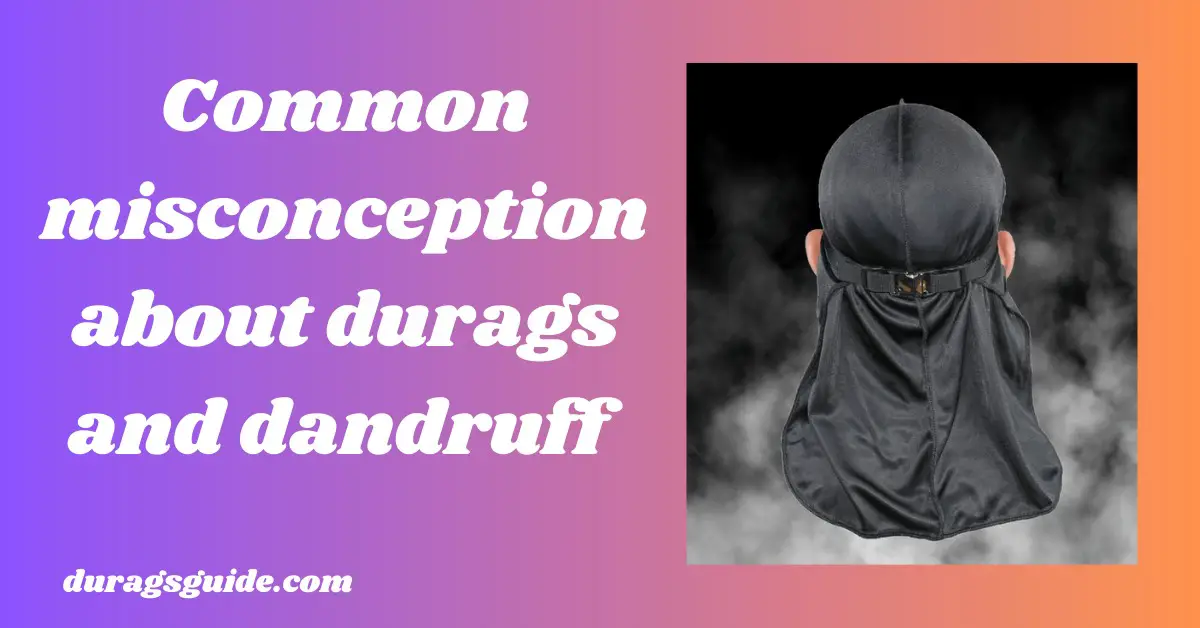
Some other 9 Tips for Preventing Dandruff While Wearing a Durag
Managing dandruff while wearing a durag requires a combination of proper durag care, scalp hygiene, and lifestyle adjustments. Here are some practical tips to prevent dandruff while wearing a durag:
- Choose Breathable Durag Materials: Opt for durags made from breathable fabrics such as silk, satin, or breathable cotton blends. These materials allow air circulation and minimize moisture buildup on the scalp, reducing the risk of dandruff.
- Clean Your Durag Regularly: Regularly launder your durag to remove sweat, oils, and product buildup that can contribute to dandruff. Use a mild detergent and wash your durag according to the manufacturer’s instructions. Avoid using harsh chemicals or bleach, as they can irritate the scalp.
- Avoid Tight Durag Tying: Tying your durag too tightly can restrict blood flow to the scalp and increase friction, leading to scalp irritation and dandruff. Opt for a snug, comfortable fit that allows adequate airflow without causing pressure on the scalp.
- Practice Scalp Hygiene: Keep your scalp clean and well-moisturized to prevent dandruff. Use a gentle shampoo formulated for dandruff or sensitive scalp, and massage it into the scalp to loosen flakes and remove buildup. Rinse thoroughly to ensure no residue remains.
- Moisturize Your Scalp: Dry scalp can exacerbate dandruff, so it’s essential to keep your scalp hydrated. Apply a moisturizing scalp oil or conditioner to nourish the scalp and prevent dryness. Avoid products containing alcohol or harsh chemicals that can strip the scalp of its natural oils.
- Limit Durag Wear Time: While durags can help maintain hairstyles and protect hair, wearing them for extended periods can trap heat and moisture, creating an ideal environment for dandruff to develop. Take breaks from wearing your durag, especially overnight, to allow your scalp to breathe and air out.
- Monitor Your Diet: Certain dietary factors, such as consuming excessive sugar, processed foods, or dairy products, can exacerbate dandruff. Maintain a balanced diet rich in vitamins, minerals, and omega-3 fatty acids, which support scalp health and reduce inflammation.
- Manage Stress Levels: Stress can trigger or worsen dandruff, so it’s essential to find healthy ways to manage stress levels. Practice relaxation techniques such as deep breathing, meditation, or yoga to reduce stress and promote overall well-being.
- Consult a Dermatologist: If you’re struggling to manage dandruff despite following these tips, consult a dermatologist for personalized advice and treatment options. They can assess your scalp condition, recommend suitable products, or prescribe medicated treatments if necessary.
Recommended Products for Dandruff Control
When dealing with dandruff while wearing a durag, using the right products can make a significant difference. Here are some recommended products specifically formulated to control dandruff and promote scalp health:
- Anti-Dandruff Shampoo: Choose an anti-dandruff shampoo that contains active ingredients such as pyrithione zinc, salicylic acid, selenium sulfide, or ketoconazole. These ingredients effectively target the underlying causes of dandruff, including fungus, excess oil, and scalp inflammation. Look for shampoos labeled as “anti-dandruff” or “scalp care” for best results.
- Scalp Exfoliating Scrub: A scalp exfoliating scrub can help remove dead skin cells, product buildup, and flakes from the scalp, reducing dandruff and promoting a healthier scalp environment. Look for gentle exfoliating scrubs with ingredients like jojoba beads, sugar, or fruit acids to avoid irritation.
- Scalp Treatment Serums: Scalp treatment serums or oils formulated with soothing and hydrating ingredients can help alleviate scalp dryness, itching, and irritation associated with dandruff. Look for serums containing tea tree oil, peppermint oil, aloe vera, or witch hazel, which have anti-inflammatory and antimicrobial properties to calm the scalp and reduce dandruff.
- Medicated Scalp Solutions: For stubborn or severe dandruff, consider using medicated scalp solutions prescribed by a dermatologist. These may include prescription-strength shampoos, scalp treatments, or topical medications containing stronger active ingredients to target dandruff and underlying scalp conditions effectively.
- Moisturizing Conditioners: Hydrating and nourishing the scalp is essential for preventing dryness and reducing dandruff. Use moisturizing conditioners or scalp masks enriched with ingredients like shea butter, coconut oil, or argan oil to replenish moisture, soften the scalp, and minimize flaking.
- Leave-In Scalp Treatments: Leave-in scalp treatments or tonics can provide ongoing relief from dandruff symptoms while wearing a durag. These products typically contain soothing ingredients like aloe vera, chamomile, or menthol to calm scalp irritation and reduce itchiness without leaving a greasy residue.
- Scalp Balancing Sprays: Scalp balancing sprays formulated with natural ingredients like apple cider vinegar or witch hazel can help restore the scalp’s pH balance, regulate oil production, and prevent dandruff recurrence. Spritz onto the scalp before or after wearing a durag to refresh and revitalize the scalp.
- Sulfate-Free Hair Care: Opt for sulfate-free shampoos, conditioners, and styling products to minimize scalp irritation and maintain a healthy scalp barrier. Sulfates can strip the scalp of its natural oils and exacerbate dandruff symptoms, so choosing gentle, sulfate-free formulas is crucial for dandruff control.
- UV Protectant Durag: Consider wearing a durag with built-in UV protection to shield the scalp from harmful UV rays, which can aggravate dandruff and scalp sensitivity. Look for durags made from UV-protective fabrics or with added UV-blocking properties to protect your scalp during outdoor activities.
- Silk or Satin Durag: Opt for silk or satin durags instead of cotton or synthetic fabrics, as these materials are gentler on the scalp and less likely to cause friction or irritation. Silk and satin durags also help retain moisture and reduce scalp dryness, minimizing the risk of dandruff formation.
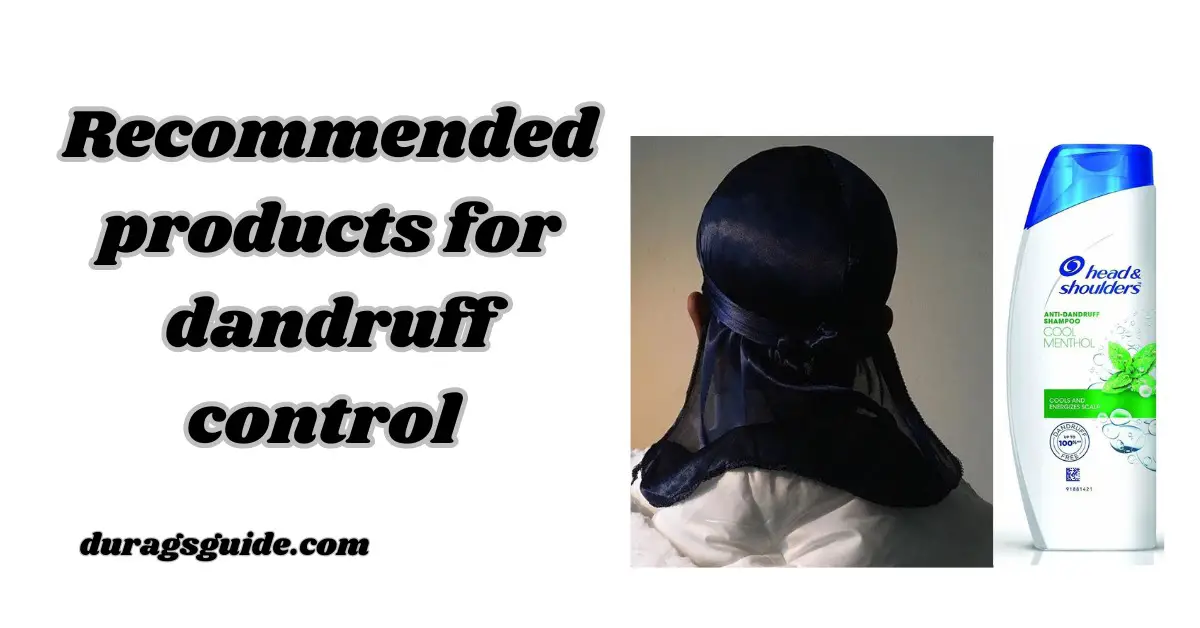
Unique 10 Tips for Preventing Dandruff While Wearing a Durag
Preventing dandruff while wearing a durag involves adopting a comprehensive approach to scalp care and hygiene. Here are some helpful tips to minimize dandruff formation and maintain scalp health:
- Keep Your Scalp Clean: Regularly wash your hair and scalp to remove dirt, oil, and product buildup, which can contribute to dandruff. Use a gentle, sulfate-free shampoo and lukewarm water to cleanse your scalp thoroughly.
- Avoid Overwashing: While cleanliness is essential, overwashing your hair can strip the scalp of its natural oils, leading to dryness and dandruff. Limit hair washing to no more than once a day or as needed to prevent excessive dryness.
- Use Lukewarm Water: Hot water can exacerbate scalp dryness and irritation, increasing the likelihood of dandruff. Opt for lukewarm water when washing your hair to avoid stripping the scalp of its natural oils and maintain moisture balance.
- Massage Your Scalp: During shampooing, gently massage your scalp with your fingertips to stimulate blood circulation and loosen dead skin cells. This helps prevent dandruff buildup and promotes a healthier scalp environment.
- Incorporate Scalp Treatments: Integrate scalp treatments into your hair care routine to address specific scalp concerns, such as dryness, itchiness, or inflammation. Choose treatments containing soothing ingredients like tea tree oil, aloe vera, or witch hazel to calm the scalp and reduce dandruff.
- Moisturize Your Scalp: Hydrate your scalp regularly to prevent dryness and flakiness, which can contribute to dandruff formation. Apply a lightweight scalp oil or moisturizing serum to nourish and hydrate the scalp, especially before wearing a durag.
- Avoid Tight Durag Styles: Tight durag styles can restrict blood flow to the scalp and increase friction, leading to irritation and dandruff. Opt for looser-fitting durags made from soft, breathable fabrics to minimize pressure on the scalp and reduce the risk of dandruff.
- Rotate Durags Regularly: Wearing the same durag repeatedly without washing can trap sweat, oil, and bacteria against the scalp, promoting dandruff and scalp issues. Rotate between multiple durags and wash them regularly to maintain scalp hygiene and prevent dandruff buildup.
- Protect Your Scalp from the Elements: Shield your scalp from harsh environmental factors, such as extreme weather conditions and pollution, which can exacerbate dandruff symptoms. Wear a durag or head covering when outdoors to protect your scalp from exposure to the elements.
- Monitor Your Diet and Lifestyle: Maintain a balanced diet rich in vitamins, minerals, and essential fatty acids to support overall scalp health. Limit consumption of processed foods, sugary snacks, and excessive caffeine, as these can contribute to scalp inflammation and dandruff. Additionally, manage stress levels and get an adequate amount of sleep to promote scalp wellness.
Seeking Professional Advice
While the aforementioned tips can help prevent dandruff while wearing a durag, it’s essential to consult a healthcare professional or dermatologist if you experience persistent scalp issues or dandruff despite your efforts. Here’s why seeking professional advice is crucial:
- Underlying Scalp Conditions: Dandruff may be a symptom of an underlying scalp condition, such as seborrheic dermatitis, scalp psoriasis, or eczema. A dermatologist can accurately diagnose any underlying scalp conditions and recommend appropriate treatment options.
- Customized Treatment Plans: A dermatologist can develop a personalized treatment plan tailored to your specific scalp concerns and skin type. This may include prescription-strength medicated shampoos, topical treatments, or oral medications to effectively manage dandruff and promote scalp health.
- Identification of Triggers: Professional guidance can help identify potential triggers for dandruff, such as allergies, hormonal imbalances, or dietary factors. By pinpointing the underlying cause of your dandruff, you can make targeted lifestyle changes to minimize flare-ups and maintain a healthy scalp.
- Evaluation of Product Use: A dermatologist can review the hair care products and durags you use to identify any potential irritants or allergens that may exacerbate dandruff. They can recommend gentle, scalp-friendly products and advise on proper hair care practices to reduce the risk of irritation and flakiness.
- Monitoring Scalp Health: Regular follow-up appointments with a dermatologist allow for ongoing monitoring of your scalp health and treatment progress. Your dermatologist can assess your response to treatment, make necessary adjustments, and provide additional support and guidance as needed.
- Prevention of Complications: Untreated or poorly managed dandruff can lead to complications such as scalp infections or hair loss. Consulting a healthcare professional early on can help prevent such complications and ensure optimal scalp health in the long term.
- Educational Resources: Dermatologists can provide valuable educational resources and guidance on proper scalp care techniques, including how to effectively cleanse, moisturize, and protect the scalp while wearing a durag. They can also offer advice on lifestyle modifications to support overall scalp wellness.

Does Wearing a Durag Cause Dandruff? Get the Answers Here
The question of whether wearing a durag causes dandruff is a common concern among individuals who regularly sport this headwear.
The association between wearing a durag and experiencing dandruff can vary depending on individual factors and habits. While wearing a durag itself may not directly cause dandruff, certain factors associated with its use could contribute to scalp issues. For instance, wearing a durag for extended periods without proper hygiene practices can create a warm, moist environment conducive to the growth of Malassezia, a yeast-like fungus that can exacerbate dandruff.
Additionally, the material of the durag can influence its impact on scalp health. Durags made from synthetic fabrics or materials that do not allow for proper airflow may trap sweat and oil against the scalp, leading to irritation and potentially dandruff. On the other hand, durags made from breathable, moisture-wicking fabrics such as silk or satin may be less likely to contribute to scalp issues.
Furthermore, the way in which a durag is worn and adjusted can also affect scalp health. Tying the durag too tightly or wearing it for prolonged periods without allowing the scalp to breathe can increase the risk of irritation and inflammation, which may manifest as dandruff.
It’s important to note that dandruff is a multifactorial condition influenced by genetics, hormonal factors, and individual scalp microbiota. While wearing a durag may not directly cause dandruff, it’s essential to maintain good scalp hygiene, choose durags made from scalp-friendly materials, and avoid prolonged periods of tight or restrictive wear to minimize the risk of scalp issues.
Ultimately, the relationship between wearing a durag and experiencing dandruff is complex and multifaceted. By adopting healthy scalp care practices and being mindful of how we wear and care for our durags, we can mitigate the risk of scalp issues and enjoy the benefits of this popular headwear accessory.
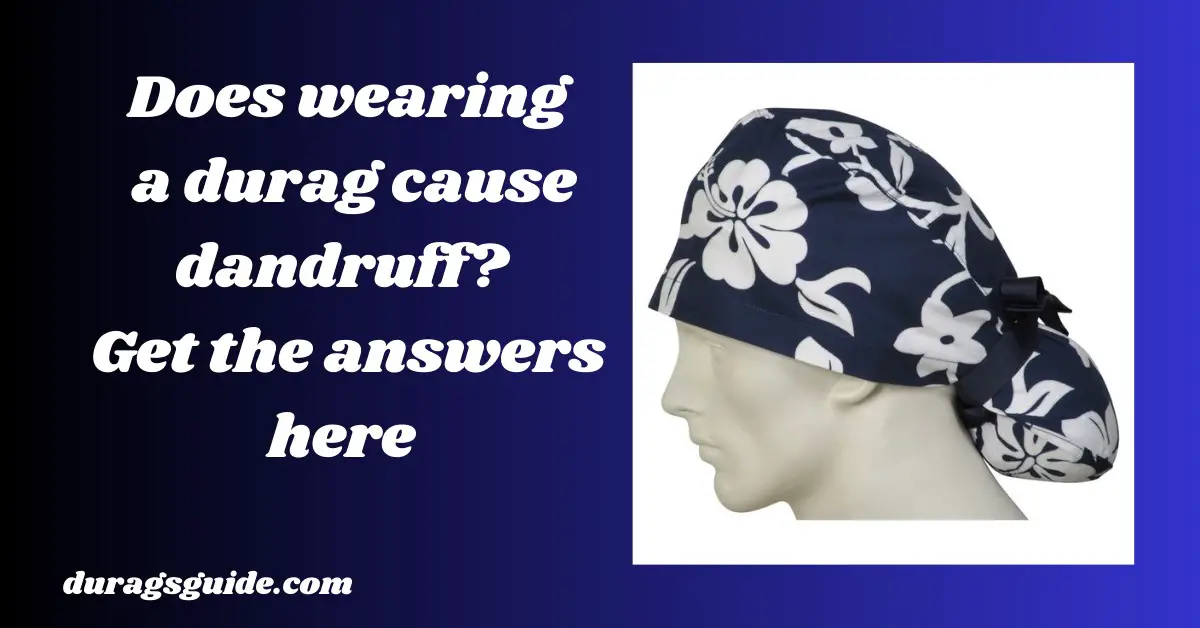
Some unique advice for readers regarding whether wearing a durag causes dandruff:
If you’re worried about dandruff while wearing a durag, don’t stress too much. It’s not just about the durag itself, but how you take care of your scalp. Make sure to keep your scalp clean and dry, wash your hair regularly, and choose a durag made from breathable materials like silk or satin. Also, try not to tie it too tight, as that can irritate your scalp. Remember, good scalp hygiene is key to keeping dandruff at bay, so take care of your hair and rock that durag with confidence!

Where to buy good durags and bandana
- Amazon: Amazon Scalp Care Products
- Sephora: Sephora Hair Care
- Ulta Beauty: Ulta Hair Care
- Walmart: Walmart Hair Care
- Target: Target Hair Care
- Sally Beauty: Sally Beauty Hair Care
- com: Hair.com Products
- eBay: eBay Hair Care
- ASOS: ASOS Hair Accessories
- Etsy: Etsy Handmade Hair Accessories
Final thoughts
In conclusion, while the question of whether wearing a durag causes dandruff may have sparked concerns, it’s important to understand that several factors contribute to scalp health. Maintaining good scalp hygiene, choosing breathable materials for headwear, and avoiding overly tight fits can all play a role in minimizing dandruff. Additionally, consulting with a dermatologist for personalized advice can be beneficial. Ultimately, with proper care and attention, you can enjoy the style and functionality of durags without worrying about dandruff.
FAQS
Are durags good for your hair?
Yes, durags can be beneficial for hair health as they help in retaining moisture, reducing breakage, and protecting hair from external elements. However, it's essential to ensure that the durag is clean and not tied too tightly to avoid any potential damage to the hair or scalp.
What are the disadvantages of wearing a durag?
Some potential disadvantages of wearing a durag include potential scalp irritation if worn too tightly, the risk of hair breakage if not cleaned regularly, and the possibility of developing dandruff if the durag traps moisture against the scalp for extended periods.
Do durags help with dandruff?
Durags themselves may not directly address dandruff, but they can help by protecting the scalp from external irritants and reducing moisture loss, which can contribute to dandruff. However, maintaining good scalp hygiene and using appropriate dandruff treatments are essential for effectively managing dandruff.
What are the disadvantages of wearing a durag?
Disadvantages of wearing a durag may include potential scalp irritation or discomfort if tied too tightly and the risk of hair breakage if not cleaned regularly. Additionally, prolonged use of a durag without proper cleaning and ventilation may trap moisture, potentially leading to scalp issues like dandruff.
